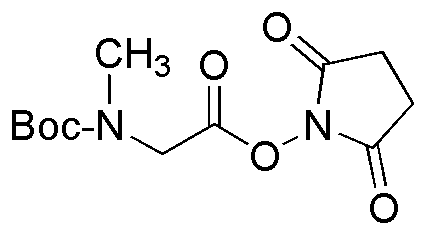Boc-sarcosine N-hydroxysuccinimide ester is widely utilized in research focused on:
- Peptide Synthesis: This compound serves as a key building block in the synthesis of peptides, enabling researchers to create complex structures with high specificity and yield.
- Drug Development: It is employed in the development of pharmaceutical compounds, particularly in creating prodrugs that enhance bioavailability and target delivery to specific tissues.
- Bioconjugation: The chemical is used for attaching biomolecules, such as proteins or antibodies, to drug molecules, improving therapeutic efficacy and stability in various medical applications.
- Diagnostics: In the field of diagnostics, it aids in the development of reagents for assays, enhancing the sensitivity and specificity of tests used in clinical settings.
- Research in Neuroscience: The compound is utilized in studies related to neurotransmitter pathways, providing insights into neurological disorders and potential treatment strategies.
General Information
Properties
Safety and Regulations
Applications
Boc-sarcosine N-hydroxysuccinimide ester is widely utilized in research focused on:
- Peptide Synthesis: This compound serves as a key building block in the synthesis of peptides, enabling researchers to create complex structures with high specificity and yield.
- Drug Development: It is employed in the development of pharmaceutical compounds, particularly in creating prodrugs that enhance bioavailability and target delivery to specific tissues.
- Bioconjugation: The chemical is used for attaching biomolecules, such as proteins or antibodies, to drug molecules, improving therapeutic efficacy and stability in various medical applications.
- Diagnostics: In the field of diagnostics, it aids in the development of reagents for assays, enhancing the sensitivity and specificity of tests used in clinical settings.
- Research in Neuroscience: The compound is utilized in studies related to neurotransmitter pathways, providing insights into neurological disorders and potential treatment strategies.
Documents
Safety Data Sheets (SDS)
The SDS provides comprehensive safety information on handling, storage, and disposal of the product.
Product Specification (PS)
The PS provides a comprehensive breakdown of the product’s properties, including chemical composition, physical state, purity, and storage requirements. It also details acceptable quality ranges and the product's intended applications.
Certificates of Analysis (COA)
Search for Certificates of Analysis (COA) by entering the products Lot Number. Lot and Batch Numbers can be found on a product’s label following the words ‘Lot’ or ‘Batch’.
Número de catálogo
Número de lote/lote
Certificates Of Origin (COO)
This COO confirms the country where the product was manufactured, and also details the materials and components used in it and whether it is derived from natural, synthetic, or other specific sources. This certificate may be required for customs, trade, and regulatory compliance.
Número de catálogo
Número de lote/lote
Safety Data Sheets (SDS)
The SDS provides comprehensive safety information on handling, storage, and disposal of the product.
DownloadProduct Specification (PS)
The PS provides a comprehensive breakdown of the product’s properties, including chemical composition, physical state, purity, and storage requirements. It also details acceptable quality ranges and the product's intended applications.
DownloadCertificates of Analysis (COA)
Search for Certificates of Analysis (COA) by entering the products Lot Number. Lot and Batch Numbers can be found on a product’s label following the words ‘Lot’ or ‘Batch’.
Número de catálogo
Número de lote/lote
Certificates Of Origin (COO)
This COO confirms the country where the product was manufactured, and also details the materials and components used in it and whether it is derived from natural, synthetic, or other specific sources. This certificate may be required for customs, trade, and regulatory compliance.


